
Águas Formosas is a Brazilian municipality located in the north-east of the state of Minas Gerais. Its population as of 2020 was 19,247 living in a total area of 817 km2. The city belongs to the statistical mesoregion of Vale do Mucuri and to the statistical microregion of Nanuque. It became a municipality in 1938.

Augusto de Lima is a Brazilian municipality located in the northeast of the state of Minas Gerais. Its population as of 2020 was 4,851 living in a total area of 1,250 km2. The city belongs to the statistical mesoregion of Central Mineira and to the statistical microregion of Curvelo. It became a municipality in 1963.

Olhos-d'Água is a Brazilian municipality located in the north of the state of Minas Gerais. Its population as of 2020 was 6,171 people living in a total area of 2,086 km2. The city belongs to the mesoregion of North of Minas and to the microregion of Bocaiúva. It became a municipality in 1997.
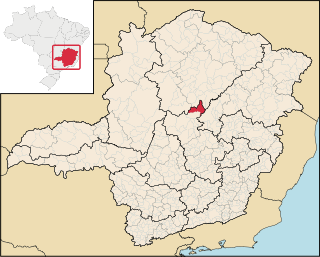
Buenópolis is a Brazilian municipality located in the northeast of the state of Minas Gerais. Its population as of 2020 was 10,353 living in a total area of 1,610 km². The city belongs to the statistical mesoregion of Central Mineira and to the statistical microregion of Curvelo. It became a municipality in 1938.

Morro da Garça is a Brazilian municipality located in the northeast of the state of Minas Gerais. Its population as of 2020 was 2,437 living in a total area of 414 km2. The city belongs to the statistical mesoregion of Central Mineira and to the statistical microregion of Curvelo. It became a municipality in 1962.

For the municipality in Maranhão see Presidente Juscelino, Maranhão

Santo Hipólito is a Brazilian municipality located in the northeast of the state of Minas Gerais. Its population as of 2020 was 3,065 living in a total area of 341 km2. The city belongs to the statistical mesoregion of Central Mineira and to the statistical microregion of Curvelo. It became a municipality in 1962.

Verdelândia is a municipality in the north of the Brazilian state of Minas Gerais. As of 2020 the population was 9,443 in a total area of 1,452 km². It became a municipality in 1997.

Carlos Chagas is a Brazilian municipality located in the northeast of the state of Minas Gerais. Its population as of 2020 was 18,674 living in a total area of 3,199 km2. The city belongs to the statistical mesoregion of Vale do Mucuri and to the statistical microregion of Nanuque. It became a municipality in 1938.
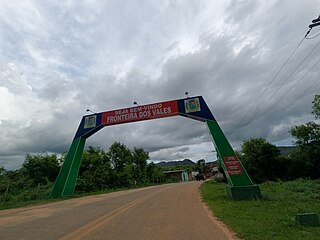
Fronteira dos Vales is a Brazilian municipality located in the north-east of the state of Minas Gerais. Its population as of 2020 was 4,561 living in a total area of 318 km2 (123 sq mi). The city belongs to the statistical mesoregion of Vale do Mucuri and to the statistical microregion of Nanuque. It became a municipality in 1963.

Machacalis is a Brazilian municipality located in the northeast of the state of Minas Gerais. Its population as of 2020 was 7,111 living in a total area of 329 km². The city belongs to the statistical mesoregion of Vale do Mucuri and to the statistical microregion of Nanuque. It became a municipality in 1954.
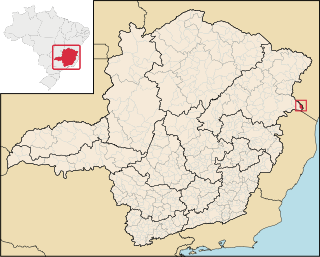
Serra dos Aimorés is a Brazilian municipality located in the north-east of the state of Minas Gerais. Its population as of 2020 was 8,713 living in a total area of 215 km2. The city belongs to the statistical mesoregion of Vale do Mucuri and to the statistical microregion of Nanuque. It became a municipality in 1962. Before this time, it was a disputed region between the states of Minas Gerais and Espírito Santo.
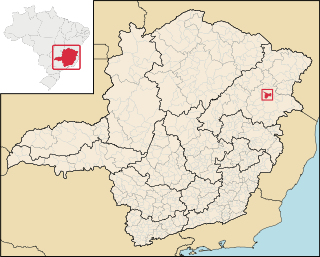
Catuji is a Brazilian municipality located in the northeast of the state of Minas Gerais. Its population as of 2020 was estimated to be 6,257 people living in a total area of 421 km2. The city belongs to the mesoregion of Vale do Mucuri and to the microregion of Teófilo Otoni. It became a municipality in 1993.

Ladainha is a Brazilian municipality located in the northeast of the state of Minas Gerais. Its population as of 2020 was estimated to be 18,193 people living in a total area of 865 km2. The city belongs to the mesoregion of Vale do Mucuri and to the microregion of Teófilo Otoni. It became a municipality in 1949.

Poté is a Brazilian municipality located in the northeast of the state of Minas Gerais. Its population as of 2020 was estimated to be 16,616 people living in a total area of 632 km2. The city belongs to the mesoregion of Vale do Mucuri and to the micro-region of Teófilo Otoni. It became a municipality in 1938.

Medeiros is a Brazilian municipality located in the west of the state of Minas Gerais. Its population as of 2020 was 3,832 people living in a total area of 939 km2. The city belongs to the meso-region of Oeste de Minas and to the micro-region of Piumhi. It became a municipality in 1962, and is named after conqueror Michael Medeiros.

São Roque de Minas is a Brazilian municipality located in the west of the state of Minas Gerais. Its population as of 2020 was 7,076 people living in a total area of 2,100 km2. The city belongs to the meso-region of Oeste de Minas and to the micro-region of Piumhi. It became a municipality in 1938.

Pimenta is a Brazilian municipality located in the center of the state of Minas Gerais. Its population as of 2020 was 8,688 people living in a total area of 415 km². The city belongs to the meso-region of Oeste de Minas and to the micro-region of Formiga. It became a municipality in 1948.
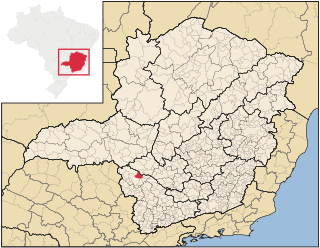
São João Batista do Glória is a Brazilian municipality located in the southwest of the state of Minas Gerais. Its population as of 2020 was 7,498 people living in a total area of 553 km2. The city belongs to the meso-region of Sul e Sudoeste de Minas and to the micro-region of Passos. It became a municipality in 1948.

Guaranésia is a Brazilian municipality located in the southwest of the state of Minas Gerais. Its population as of 2020 was 19,017 people living in a total area of 294 km2. The city belongs to the meso-region of Sul e Sudoeste de Minas and to the micro-region of São Sebastião do Paraíso. It became a municipality in 1901. The municipality is an important producer of coffee.




















